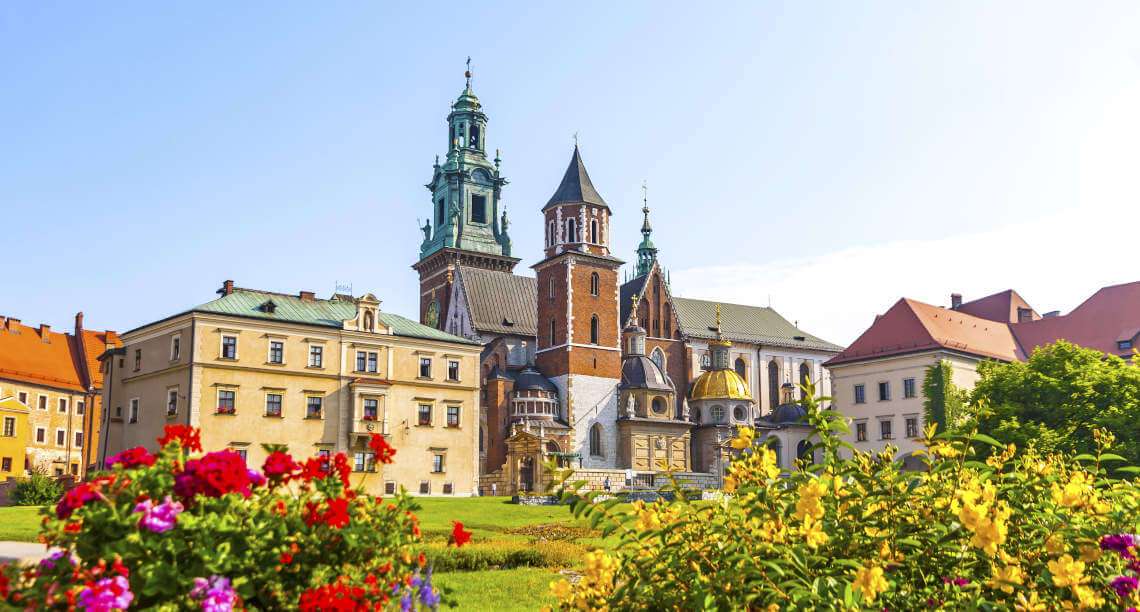
Undoubtedly the most important and most popular attraction of Krakow. A walk through Krakow’s Old Town is a must for every visit to the city. It is here that you can see world-class monuments, including the Cloth Hall, the Church of St. Mary, the Town Hall tower, the Church of St. Adalbert, and numerous historical classical buildings. Visitors also like the unique atmosphere of the Market Square, which is the main meeting place and the ideal starting point for exploring Krakow.

The former seat of Polish rulers and kings is the second and most important attraction of Cracow. The historic building located on the Wawel Hill on the left bank of the Vistula River has deservedly been included in the UNESCO World Heritage List. The famous legend about the Wawel Dragon is undoubtedly one of the most famous legends related to the capital of the Lesser Poland Region.

It is one of the most recognizable churches in Poland. Erected in the fourteenth and fifteenth century, the Gothic building is distinguished by two towers visible from afar, whose construction is described by an interesting legend about the Yellow Pipe. It is from here that every hour the bugle call is played on four sides of the world. What is interesting, the bugle callers are on 24-hour duty, and during the day the bugle call is played alternately by two firemen. The interior of the church hides a magnificent altar of Wit Stwosz, showing scenes from the life of Christ. The whole is made in oak wood, and is now over 1000 years old!

The biggest commercial attraction of Krakow, which has been a marketplace for centuries, combines the interests of buyers and sellers. As in the past, today the Cloth Hall is full of stalls offering jewellery, handicrafts, and souvenirs. The first floor of the Cloth Hall hosts exhibitions by the Gallery of 19th century Polish Painting and Sculpture.

This is the most important church in Krakow; this is where Polish history was shaped by the king’s hands. This is where the coronations and burials of Polish heads of state took place. Seventeen Polish rulers (practically all kings, including Stefan Batory, Ladislaus IV Vasa, Sigismund II August, Sigismund II the Strong, Sigismund III Vasa and John Casimir Vasa), bishops, and famous and outstanding figures of Polish culture are buried here. In the centre of the cathedral, there is a reliquary with the remains of St. Stanislaus.

Commonly known as Rondel. This massive building of extremely original construction is the northernmost part of the city fortifications in Krakow. Until the end of the 18th century, the Barbican was an impregnable structure. Today, this unique building is a branch of the Historical Museum of the City of Krakow.

This is the oldest building belonging to the Jagiellonian University. Wonderful arcaded cloisters with crystal vaults, a well located in the middle of the courtyard, and historic stairs leading to the first floor have delighted tourists for decades. The historic portal leading to the courtyard is also worth visiting.

One of the oldest museums in Poland, founded by Princess Izabela Czartoryska, a collector of valuable works of European and Middle Eastern art. You can see here works of Leonardo da Vinci (the famous “Lady with an Ermine”), Rembrandt, Pieter Brueghel the Younger. The Gallery of Ancient Art is located in the former city arsenal.
Today, this is a cult place where Bishop Karol Wojtyła, who later became Pope John Paul II, lived between 1964 and 1978. And it was here where he talked to the crowds gathering under the palace from the so-called “papal window”. Until this day, the place still sees and influx of tourists from all over Poland and abroad. The Bishop’s Palace is the second biggest Krakow palace, right after Wawel Castle.

Often also called the Cemetery of Great Poles, this place is located in the basement of the Pauline Church on the Rock [the Rock is known as Skałka]. Being the most important national pantheon in Poland, the Crypt of Honour is the place of the eternal rest of Jacek Malczewski, Karol Szymanowski, Ludwik Solski, Wincenty Pol, Józef Ignacy Kraszewski, Adam Asnyk, Stanisław Wyspiański, Teofil Lenartowicz, Tadeusz Banachiewicz, and Czesław Miłosz.

Krakow’s Kazimierz District is the centre of cultural life and one of the most visited places in Krakow. There are many historic synagogues – Old Synagogue, Isaac Synagogue, Kupa Synagogue, Remuh Synagogue, Tempel Synagogue , and churches – Corpus Christi Church, Church of St. Catherine, Church St. Trinity, and the Church on the Rock. Life here concentrates mainly around the New Square, also called the Jewish Square. Every year, the Jewish Culture Festival held in this part of Krakow attracts crowds of tourists.
Source:
http://alekrakow.pl/zabytki-krakowa
https://polskazachwyca.pl/top-10/zabytki-krakowa-poznaj-7-flagowych-atrakcji/

Krakow and the Tatra Mountains are about 85 kilometres away in a straight line. You can admire these splendid mountains without leaving the city, straight from the streets of Krakow, and without having to use special tools. The Tatra panorama is visible from the northern districts of Krakow, from the highest points of the city, with favourable weather conditions and good visibility.
Source: https://portaltatrzanski.pl/wiedza/przyroda/dlaczego-z-krakowa-widac-tatry,301